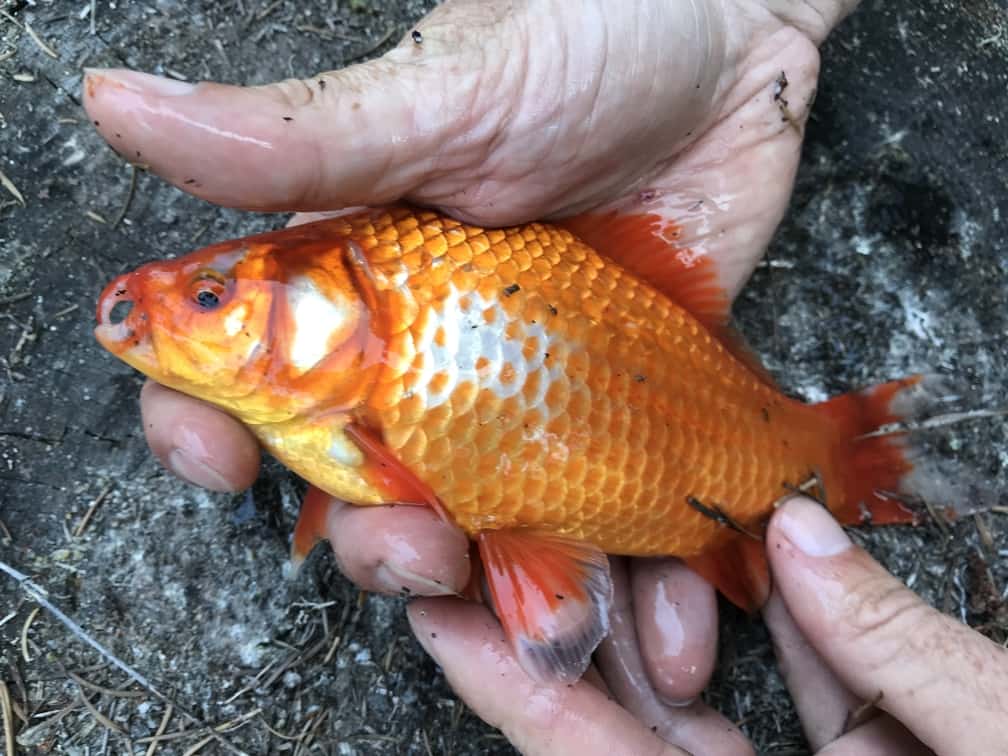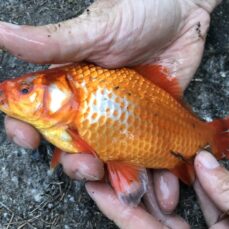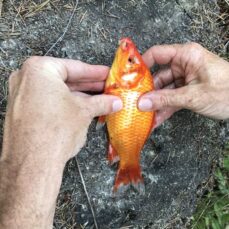
Management Category
Squamish
Whistler
Pemberton
Vectors of Spread
ID Characteristics
Size: Mature goldfish are typically 12 – 22 cm long. Their size is only limited by their environment; once in a pond or a lake, they may reach up to 40 cm if they have access to a varied and abundant diet.
Females may look wider before spawning since they carry their eggs in their abdomens.
Colour: Bright orange to olive green or creamy white. In the wild, goldfish are typically olive to gray.
Scales: Goldfish have a lateral line of 25 – 31 scales that runs from the head to the tail. They help the fish detect movement in the water. Goldfish don’t have scales on their heads.
Fins and tail:
- Long dorsal fin with 15 – 21 rays and a hard spine
- Deeply-forked tail
- The male anal fin (the one closest to the tail) is concave, whereas in females it is convex.
Lifespan: Goldfish usually have a lifespan of 6 or 7 years, but the oldest specimen reported was 30 years old.
Similar Species

Koi have barbels, whereas goldfish don’t.
(Photo credit: Stan Shebs, Wikipedia)
There are several native and non-native species of minnows and carps (Cyprinidae) that occur in BC. However, goldfish have a dorsal fin that is longer than their heads; the stiff, toothed spine at the base of their dorsal and anal fins is another point of distinction.
Invasive: Goldfish are sometimes confused with, and often referred to as koi. Both species are invasive and are likely to have similar impacts. You can tell them apart by looking at the lower lip – goldfish lack barbels (whisker-like projections) that are present in koi.
Scroll down to the bottom of the species profile page for more koi images.
Habitat and Origin
Origin: Goldfish are originally from Eastern Asia, including parts of China, Hong Kong, Japan and Korea. They are now a common pet and have unfortunately been released into the wild, or have escaped into some water bodies in BC.
Habitat: Goldfish prefer areas with submerged vegetation, like streams, ditches, and ponds. They can tolerate a wide range of temperatures and oxygen levels and are unaffected by ice cover.
How it Spreads
Goldfish usually have a lifespan of 6 or 7 years, but the oldest specimen reported was 30 years old.
Reproduction: Goldfish reproduce rapidly and prolifically. Spawning occurs in shallow water among vegetation, where the females lay up to several hundred thousand eggs at once. The eggs are sticky and adhere to nearby plants and rocks to be fertilized by a male. Females can spawn 3 – 10 lots of eggs, 8 – 10 days apart.
Vectors of spread: Well-meaning pet owners have been known to release their goldfish into BC water bodies. In other cases, goldfish have escaped from ponds and aquariums. Once introduced, they can become established and spread easily to connected water bodies.
Impacts
- Goldfish compete with and even prey upon native fish species.
- They can disturb sediment while feeding, which increases water turbidity and harms aquatic plants.
- Goldfish can carry diseases such as koi herpesvirus that can harm local fish populations.
- Goldfish are extremely resistant and feed on various crustaceans, insects, smaller fish and vegetation.
Prevent the Spread
Goldfish have been have been observed in several water bodies in the Sea to Sky region. PREVENTION of further spread is key.
Under s10 of the federal Aquatic Invasive Species Regulation, it is prohibited to introduce an aquatic species into a region or body of water frequented by fish where it is not indigenous unless authorized to do so under federal or provincial law. This includes moving aquatic species from the pet/aquarium or food trade into natural waters.
Learn to identify goldfish: use the images presented on this profile page.
What to do if you spot it: You can report any goldfish sighting by visiting our reporting page.
Don’t let it loose. Through public education and awareness, we encourage pet owners to consider re-homing services and rescue centers for unwanted aquarium fish or euthanasia as a last resort. Re-homing services in the Sea to Sky include:
Never use goldfish as live bait.
If you catch Goldfish:
- The BC Freshwater Fishing Regulations outline when and how to fish with a Recreational Fishing License. These regulations vary by region and water body and are in place to protect native fish populations and sensitive aquatic habitats.
- Any fishing or capture method beyond what is permitted by a Recreational Fishing License requires a provincial Scientific Collection Permit.
- In water bodies where a species quota is not specified, the species may be retained unless general regulations prevent retention (e.g., release all fish).
- Call the Conservation Officers (1-877-952-7277)
Control
Mechanical control: Mechanical control methods may suppress goldfish populations but are unlikely to eradicate them.
Nevertheless, population suppression efforts may help reduce biomass and lessen goldfish’s negative impacts. Mechanical removal methods may include hook & line fishing, gill-netting and electrofishing. In the right conditions, repeated electrofishing (with scoop netting) can remove some unwanted fish, but goldfish often swim deep or hide in vegetation and mud to escape the electrofisher, so complete eradication is unlikely.
Another option (where feasible) is to drain a water body completely and let it freeze completely over winter, but this method is not well-documented.
Most mechanical control methods require permits; please contact SSISC for more information.
Chemical control: In other regions of BC, invasive fish have been eradicated by applying a piscicide (e.g., rotenone) to a water body. The water body needs to be restocked with native fish afterwards, since the pesticide affects all gill-breathing organisms. There is a lengthy permitting and approval process in place for this type of control; at this time, there are no plans to use this method in the Sea to Sky.
Biological control: Natural predators like birds of prey don’t eat goldfish at a level that would suppress the population, so population control is currently unlikely.
Sea to Sky Distribution
Goldfish Factsheet
Additional Resources
References
- CABI Digital Library, Carassius auratus auratus (goldfish)
- CBC News, ‘Invasive goldfish the size of footballs are spreading from Vancouver to other parts of B.C., researcher warns’
- Fraser Valley Invasive Species Society, Goldfish
- Government of British Columbia, Goldfish Invasive Species Alert Factsheet
- Government of Canada, Goldfish
- Invasive Species Council of BC, Goldfish
- Invasive Species Centre, Goldfish
- Ministry of Forests, Lands, Natural Resources Operations & Rural Development Contacts, personal communication with Andrew Klassen
- Minnesota Department of Natural Resources, Goldfish and Koi Best Management Practices
- Ontario’s Invading Species Awareness Program, Goldfish
- Thompson Rivers University, personal communication with Brian Hiese
- Resort Municipality of Whistler, personal conversations











